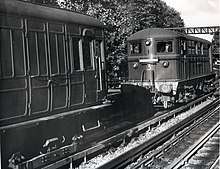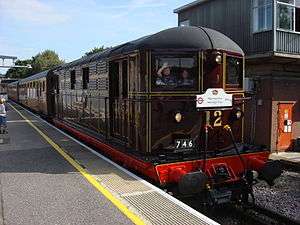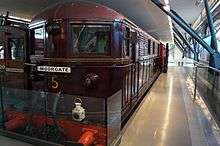Metropolitan Railway electric locomotives
Metropolitan Railway electric locomotives were used on London's Metropolitan Railway with conventional carriage stock. On the outer suburban routes an electric locomotive was used at the Baker Street end that was exchanged for a steam locomotive en route.

.jpg)
The first ten had a central cab and were known as camel-backs, and these entered service in 1906. A year later another ten units with a box design and a driving position both ends arrived. These were replaced by more powerful units in the early 1920s.
The locomotives were withdrawn from passenger service in 1962 after electrification reached Amersham and the A Stock electric multiple units entered service. One locomotive, No. 5 John Hampden, is preserved as a static display at London Transport Museum, and another, No. 12 Sarah Siddons, has been used for heritage events.
Westinghouse
The Metropolitan Railway ordered electric locomotives from British Westinghouse and made by Metropolitan Amalgamated. The first ten were built with Westinghouse electrical control equipment and entered service in 1906. These 'camel-back' bogie locomotives featured a central cab,[1] weighed 50 tons, were 35 feet 9 inches (10.90 m) long over the buffers and had four 215 hp (160 kW) traction motors. Initially there was only one position for the driver which give difficulties, and a second master controller was soon added.[2]
British Thompson Houston
The second ten, also constructed by Metropolitan Amalgamated, were built to a box car design with British Thompson Houston control equipment.[1] These locomotives weighed 47 tons, and were 33 feet 6 inches (10.21 m) long over buffers and entered service in 1907. The control equipment was replaced with the Westinghouse type in 1919.[2]
Metropolitan-Vickers
| Metropolitan Railway "Metro-Vick" | |||||||||||||||||||
|---|---|---|---|---|---|---|---|---|---|---|---|---|---|---|---|---|---|---|---|
 No. 12 Sarah Siddons at Amersham in 2008 | |||||||||||||||||||
| |||||||||||||||||||
| |||||||||||||||||||
| |||||||||||||||||||
| |||||||||||||||||||
In the early 1920s, the Metropolitan placed an order with Metropolitan-Vickers of Barrow-in-Furness for rebuilding the twenty electric locomotives. When work started on the first locomotive, it was found to be impractical and uneconomical and the order was changed to building completely new locomotives using some equipment recovered from the originals. The new locomotives were built in 1922-1923 and weighing 61½ tons,[4] they had four 300 hp (220 kW) motors, giving a one-hour rating of 1,200 hp (890 kW) and a top speed of 65 mph (105 km/h).[5]
In 1925, no. 15 was exhibited on the Metropolitan Railway's stand at the British Empire Exhibition; the panelling was removed from one side, so that the equipment inside could be viewed.[6] The locomotives were all named, the first nameplates being fitted on 18 March 1927. Nineteen of the names chosen were of people, real or fictitious, who had a connection with the area served by the Metropolitan; the exception was no. 15, the exhibition locomotive of 1925, which became Wembley 1924.[7] Nameplates were removed during World War II.[8]
In 1953 the fifteen remaining locomotives were overhauled and the traction control equipment replaced by BTH equipment from District line cars. Nameplates were refitted.[9]
After electrification to Amersham was completed in 1961, the locomotives were withdrawn from passenger service although three were kept as shunters.[9]
One locomotive, No. 5 John Hampden, is preserved as a static display at London Transport Museum[10] and another, No. 12 Sarah Siddons, has been used for heritage events, most recently in January 2013 running in conjunction with Metropolitan Railway Locomotive No. 1 on steam excursions to mark the 150th anniversary of the opening of the Metropolitan Railway.[11]

List of Locomotives
| Key: | Scrapped | Preserved |
|---|
| Number | Name | Withdrawn | Notes |
|---|---|---|---|
| 1 | John Lyon | 1962 | Still stored at Neasden Depot in May 1969 |
| 2 | Oliver Cromwell | 1962 | Named Thomas Lord in 1953 |
| 3 | Sir Ralph Verney | 1962 | |
| 4 | Lord Byron | 1962 | |
| 5 | John Hampden | 1962 | Preserved in the London Transport Museum |
| 6 | William Penn | 1962 | |
| 7 | Edmund Burke | 1962 | |
| 8 | Sherlock Holmes | 1962 | |
| 9 | John Milton | 1962 | |
| 10 | William Ewart Gladstone | 1962 | |
| 11 | George Romney | 1962 | |
| 12 | Sarah Siddons | 1962 | Preserved in working order |
| 13 | Dick Whittington | 1962 | |
| 14 | Benjamin Disraeli | 1962 | |
| 15 | Wembley 1924 | 1951 | Scrapped following an accident |
| 16 | Oliver Goldsmith | 1962 | Scrapped in 1966 |
| 17 | Florence Nightingale | 1943 | Scrapped following an accident |
| 18 | Michael Faraday | 1962 | Scrapped in 1966 |
| 19 | John Wycliffe | 1948 | |
| 20 | Sir Christopher Wren | 1954 | Scrapped following an accident |
Accidents and incidents
- On 18 June 1925, locomotive No.4 collided with a passenger train at Baker Street station when a signal was changed from green to red just as the locomotive was passing it. Six people were injured.[12]
References
| Wikimedia Commons has media related to Metropolitan Railway electric locomotives. |
Notes
- Green 1987, p. 26.
- Bruce 1983, pp. 58-59.
- Hollingsworth, Brian; Cook, Arthur (2000). "Nos 1–20 Bo-Bo". Modern Locomotives. pp. 42–43. ISBN 0-86288-351-2.
- Bruce 1983, p. 58.
- Benest 1984, p. 48.
- Day 1979, p. 68
- Day 1979, p. 69.
- Bruce 1983, p. 59.
- Bruce 1983, p. 60.
- "Metropolitan Railway electric locomotive No. 5, "John Hampden", 1922". ltmcollection.org. Retrieved 27 February 2012.
- Brown, Larisa (13 January 2013). "Rolling back into the golden age of steam: London Underground celebrates 150th anniversary of first Tube journey". Daily Mail.
- Earnshaw, Alan (1989). Trains in Trouble: Vol. 5. Penryn: Atlantic Books. p. 20. ISBN 0-906899-35-4.
Bibliography
- Bruce, J Graeme (1983). Steam to Silver. Capital Transport.CS1 maint: ref=harv (link)
- Day, John R. (1979) [1963]. The Story of London's Underground (6th ed.). Westminster: London Transport. ISBN 0-85329-094-6. 1178/211RP/5M(A).CS1 maint: ref=harv (link)
- Green, Oliver (1987). The London Underground — An illustrated history. Ian Allan.CS1 maint: ref=harv (link)
- Benest, K.R. (1984) [1963]. Metropolitan Electric Locomotives (2nd ed.). Hemel Hempstead: London Underground Railway Society. ISBN 0-9508793-1-2.CS1 maint: ref=harv (link)